Related Research Articles
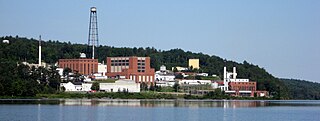
Chalk River Laboratories is a Canadian nuclear research facility in Deep River, about 180 km (110 mi) north-west of Ottawa.
Atomic Energy of Canada Limited (AECL) is a Canadian Crown corporation and the largest nuclear science and technology laboratory in Canada. AECL developed the CANDU reactor technology starting in the 1950s, and in October 2011 licensed this technology to Candu Energy.

Bruce Nuclear Generating Station is a nuclear power station located on the eastern shore of Lake Huron in Ontario, Canada. It occupies 932 ha of land. The facility derives its name from Bruce Township, the local municipality when the plant was constructed, now Kincardine due to amalgamation. With eight CANDU pressurized heavy-water reactors, it was the world's largest fully operational nuclear generating station by total reactor count and the number of currently operational reactors until 2016, when it was exceeded in nameplate capacity by South Korea's Kori Nuclear Power Plant. The station is the largest employer in Bruce County, with over 4000 workers.
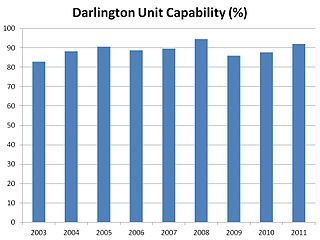
Darlington Nuclear Generating Station is a Canadian nuclear power station located on the north shore of Lake Ontario in Bowmanville, Ontario. It is a large nuclear facility comprising four CANDU nuclear reactors with a total output of 3,512 MWe when all units are online, providing about 20 percent of Ontario's electricity needs, enough to serve a city of two million people. The reactor design is significantly more powerful than those used in previous CANDU sites at Pickering and Bruce, making its 4-unit plant the second-largest in Canada behind the 8-unit Bruce. It is named for the Township of Darlington, the name of the municipality in which it is located, which is now part of the amalgamated Municipality of Clarington.
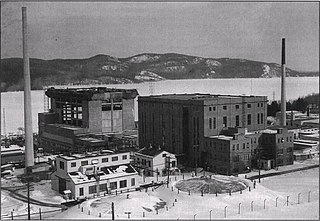
The ZEEP reactor was a nuclear reactor built at the Chalk River Laboratories near Chalk River, Ontario, Canada. ZEEP first went critical at 15:45 on September 5, 1945. ZEEP was the first operational nuclear reactor outside the United States.

The Santa Susana Field Laboratory (SSFL), formerly known as Rocketdyne, is a complex of industrial research and development facilities located on a 2,668-acre (1,080 ha) portion of Southern California in an unincorporated area of Ventura County in the Simi Hills between Simi Valley and Los Angeles. The site is located approximately 18 miles (29 km) northwest of Hollywood and approximately 30 miles (48 km) northwest of Downtown Los Angeles. Sage Ranch Park is adjacent on part of the northern boundary and the community of Bell Canyon is along the entire southern boundary.
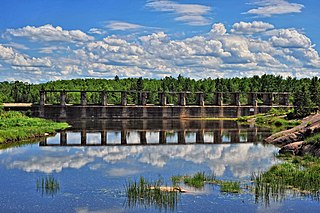
Pinawa is a local government district and small community of 1,331 residents located in southeastern Manitoba, Canada. It is 110 kilometres north-east of Winnipeg. The town is situated on the Canadian Shield within the western boundary of Whiteshell Provincial Park, which lies near the Manitoba-Ontario provincial boundary. Administratively, the town includes the surrounding area, and is officially the Local Government District of Pinawa. Except for a small eastern border with the unorganized area of the Eastman Region, it is surrounded by the Rural Municipalities of Lac du Bonnet to the north and Whitemouth to the south, but is independent of either one. The community lies on the north bank of the Winnipeg River in the southeastern part of the Local Government District.

Research reactors are nuclear fission-based nuclear reactors that serve primarily as a neutron source. They are also called non-power reactors, in contrast to power reactors that are used for electricity production, heat generation, or maritime propulsion.
The National Research Universal (NRU) reactor was a 135 MW nuclear research reactor built in the Chalk River Laboratories, Ontario, one of Canada’s national science facilities. It was a multipurpose science facility that served three main roles. It generated radionuclides used to treat or diagnose over 20 million people in 80 countries every year. It was the neutron source for the NRC Canadian Neutron Beam Centre: a materials research centre that grew from the Nobel Prize-winning work of Bertram Brockhouse. It was the test bed for Atomic Energy of Canada Limited to develop fuels and materials for the CANDU reactor. At the time of its retirement on March 31, 2018, it was the world's oldest operating nuclear reactor.

The SLOWPOKE is a family of low-energy, tank-in-pool type nuclear research reactors designed by Atomic Energy of Canada Limited (AECL) beginning in the late 1960s. John W. Hilborn is the scientist most closely associated with their design. They are beryllium-reflected with a very low critical mass, but provide neutron fluxes higher than available from a small particle accelerator or other radioactive sources.
The Canadian Nuclear Safety Commission is the federal regulator of nuclear power and materials in Canada.
Nuclear power in Canada is provided by 19 commercial reactors with a net capacity of 13.5 gigawatt (GW), producing a total of 95.6 terawatt-hours (TWh) of electricity, which accounted for 16.6% of the country's total electric energy generation in 2015. All but one of these reactors are located in Ontario, where they produced 61% of the province's electricity in 2019. Seven smaller reactors are used for research and to produce radiopharmaceuticals for use in nuclear medicine.
The Whiteshell Reactor No. 1, or WR-1, was a Canadian research reactor located at AECL's Whiteshell Laboratories (WNRL) in Manitoba. Originally known as Organic-Cooled Deuterium-Reactor Experiment (OCDRE), it was built to test the concept of a CANDU-type reactor that replaced the heavy water coolant with an oil substance. This had a number of potential advantages in terms of cost and efficiency.

The Whiteshell River is one of the major rivers in Whiteshell Provincial Park, in southeastern Manitoba, Canada, near the Ontario border. This river is close to some petroform sites that are about 2000 years old or older. The name "whiteshell" is in reference to the Meegis or cowry shells used by Ojibwa peoples in their ceremonies and teachings, especially the Midewiwin, and as recorded in their birch bark scrolls.
Nuclear entombment is a method of nuclear decommissioning in which radioactive contaminants are encased in a structurally long-lived material, such as concrete. This prevents radioactive material and other contaminated substances from being exposed to human activity and the environment. Entombment is usually applied to nuclear reactors, but also some nuclear test sites. Nuclear entombment is the least used of three methods for decommissioning nuclear power plants, the others being dismantling and deferred dismantling. The use of nuclear entombment is more practical for larger nuclear power plants that are in need of both long and short term burials, as well as for power plants which seek to terminate their facility licenses. Entombment is used on a case-by-case basis because of its major commitment with years of surveillance and complexity until the radioactivity is no longer a major concern, permitting decommissioning and ultimate unrestricted release of the property. Considerations such as financial backing and the availability of technical know-how are also major factors.
The Deep Geologic Repository Project (DGR) was a proposal by Ontario Power Generation (OPG) in 2002 for the site preparation, construction, operation, decommissioning and abandonment of a deep geological radioactive waste disposal facility for low and intermediate-level radioactive waste (L&ILW). In 2005, the municipality of Kincardine, Ontario volunteered to host the facility located on the Bruce nuclear generating station adjacent to OPG's Western Waste Management Facility (WWMF). The facility would have managed L&ILW produced from the continued operation of OPG-owned nuclear generating stations at the Bruce, Pickering Nuclear Generating Station and Darlington Nuclear Generating Station in Ontario. In May 2020, after 15 years of environmental assessment, OPG withdrew its application for a construction license on Saugeen Ojibway Nation Territory.

Nuclear industry in Canada is an active business and research sector, producing about 15% of its electricity in nuclear power plants of domestic design. Canada is the world's largest exporter of uranium, and has the world's second largest proven reserves. Canada also exports nuclear technology within the terms of the Nuclear Non-proliferation Treaty, to which it is a signatory, and is the world's largest producer of radioactive medical isotopes.
The Underground Research Laboratory was a test site for deep geological repository of nuclear waste operated by Atomic Energy of Canada Limited's (AECL's) Whiteshell Laboratories near Lac du Bonnet in Manitoba, Canada. The site was built inside a large granite batholith, typical of the Canadian Shield. The site was selected in 1980, construction began in 1982 and it opened in 1985. No radioactive material was stored at the site, it was used purely for measurements of water exchange, rock movement, and other issues that would affect the safety of such materials. The site was also used by a variety of international users. As part of the wider wind-down of AECL activities, the decision was made to close the URL in 2003. Cleanup work began in 2006 and completed in 2010. The site continues to host a single international experiment measuring water leakage through a massive clay plug.
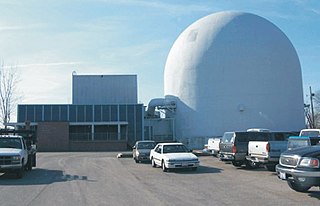
An organic nuclear reactor, or organic cooled reactor (OCR), is a type of nuclear reactor that uses some form of organic fluid, typically a hydrocarbon substance like polychlorinated biphenyl (PCB), for cooling and sometimes as a neutron moderator as well.
Canadian Nuclear Laboratories (CNL) research facilities are located in Chalk River, Ontario, Canada, approximately 180km north-west of Ottawa. There are three new additions to the site. The Logistics Warehouse contains a large reception space, offices, and storage. The Support and Maintenance Facility houses equipment, offices, and flexible open spaces. The Science Collaboration Centre has studios, laboratories, and administrative spaces.
References
- 1 2 3 4 5 6 Impact Assessment Agency of Canada (n.d.). CNSC Disposition Table of Public and Indigenous Groups’ Comments on the Draft Environmental Impact Statement-WR-1. https://registrydocumentsprd.blob.core.windows.net/commentsblob/project-80124/comment-24041/121947E.pdf
- ↑ Searle, Tyler (2023, August 4). Decommission work halted at old nuclear facility in Whiteshell. Winnipeg Free Press.
- 1 2 3 4 5 6 Saunders, Chris (2016). Whiteshell Laboratories. Whiteshell History Committee.
- ↑ "Whiteshell labs". Canadian Nuclear Safety Commission . Retrieved 2012-07-26.
- 1 2 Owen, Bruce (December 8, 2010). "Whiteshell labs closes underground facility forever". Winnipeg Free Press . Retrieved October 11, 2014.
- ↑ "Whiteshell Decommissioning". Canadian Nuclear Laboratories.
- 1 2 3 Canadian Nuclear Laboratories (n.d.) WR-1 Decommissioning. https://www.cnl.ca/environmental-stewardship/wr-1-reactor-decommissioning/
- 1 2 3 4 Canadian Nuclear Safety Commission (n.d.) Regulatory review status for the decommissioning of the Whiteshell Reactor #1. https://nuclearsafety.gc.ca/eng/reactors/research-reactors/other-reactor-facilities/whiteshell-decommissioning.cfm
- ↑ Government of Canada Justice Laws Website (1997). Nuclear Safety and Control Act (S.C. 1997, c.9). https://laws-lois.justice.gc.ca/eng/acts/N-28.3/
- ↑ Canadian Nuclear Laboratories (2017, September 13). Environmental Impact Statement In Situ Decommissioning of WR-1 at the Whiteshell Laboratories Site. https://www.gov.mb.ca/sd/eal/registries/5895pinawa_nuclear_plant/2A_Main_Body_Environmental_Impact_Statement_In_Situ_Decommissioning_of_WR_1_PART_1_of_2_Main%20Body.pdf
- 1 2 3 Manitoba Metis Federation (2023, August 11). The Manitoba Metis Federation and Canadian Nuclear Laboratories Sign Five-year Contribution Agreement. https://www.mmf.mb.ca/news/the-manitoba-metis-federation-and-canadian-nuclear-laboratories-sign-five-year-contribution-agreement
- ↑ "CNSC Staff Report on the Performance of CNL's Nuclear Sites and Projects: 2013 - Canadian Nuclear Safety Commission". www.nuclearsafety.gc.ca. Archived from the original on 2015-06-07.
- ↑ "CNSC renews Whiteshell Laboratories site licence". Canadian Nuclear Laboratories. 17 Dec 2024. Retrieved 19 Jan 2025.